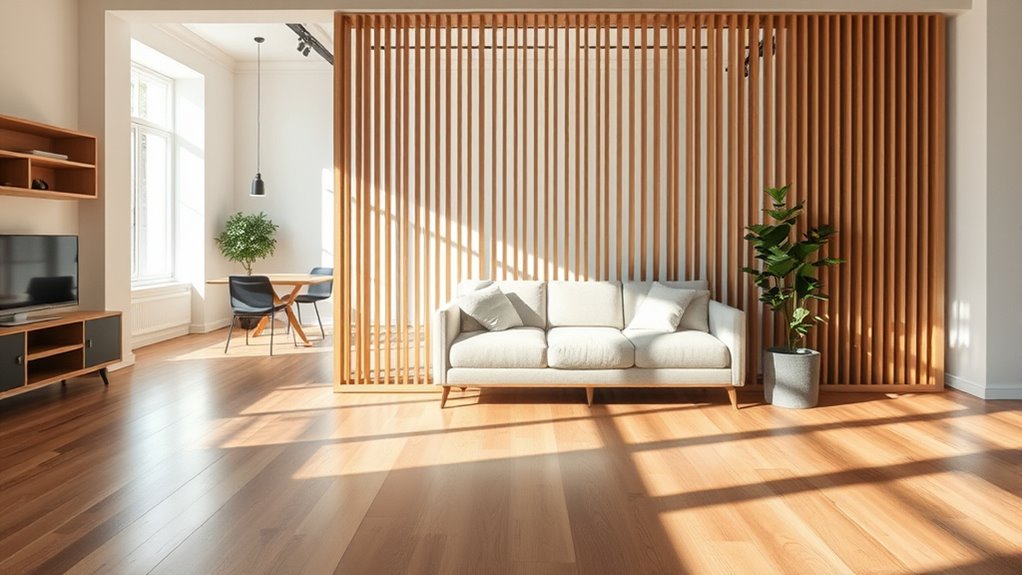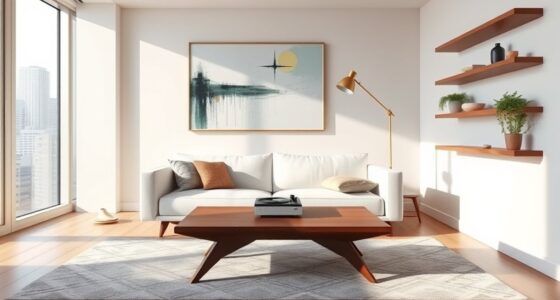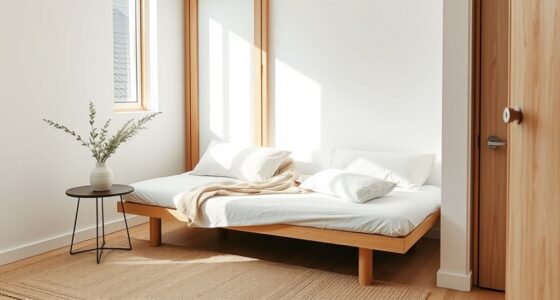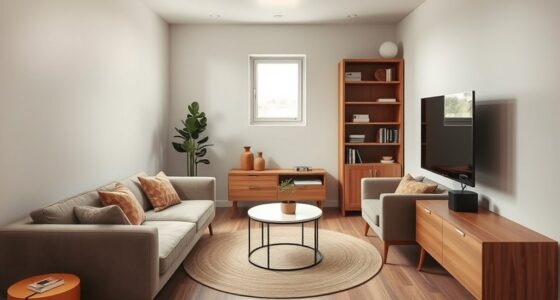In open studio living, clever room dividers like multi-functional furniture, foldable screens, and curtains help you define separate zones while keeping the space airy and flexible. You can use sleek bookshelves or sofas as visual barriers, or opt for lightweight sliding panels and curtains that are easy to move and reconfigure. These ideas blend style and practicality, creating personal spaces without sacrificing openness—if you want to explore more options, there’s plenty to discover.
Key Takeaways
- Use multi-functional furniture like bookshelves to separate sleeping and working zones without sacrificing openness.
- Incorporate lightweight, movable privacy screens or sliding panels for flexible space division.
- Install curtains with rods to quickly create privacy or open up areas as needed.
- Employ sofas or benches as natural visual dividers that define different functional zones.
- Combine aesthetic and practical solutions by choosing materials and colors that seamlessly blend with your open studio decor.

Have you ever wondered what it’s like to live in a space that blurs the line between work and home? Open studio living makes that possible, but it also brings the challenge of creating separate zones within one open area. That’s where clever room dividers come into play. Instead of traditional walls, you can use multi functional furniture and privacy partitioning to define your spaces without sacrificing the airy, open feel you want.
Imagine a sleek bookshelf that doubles as a room divider. It not only provides storage and display space but also acts as a visual barrier, subtly separating your sleeping area from your workspace. Multi functional furniture like this makes your apartment feel more organized and intentional. When you need to change the layout, you can move the bookshelf, creating new zones whenever necessary. You don’t have to commit to permanent structures; instead, you get flexibility and style rolled into one.
Privacy partitioning isn’t just about blocking sightlines; it’s about creating a sense of personal space. Foldable screens or sliding panels work great for this purpose. They can be easily tucked away when you want an open atmosphere, then pulled out when you need privacy. These partitions are often lightweight yet sturdy, making them easy to reposition as your needs evolve. Plus, choosing materials and colors that complement your decor keeps the space feeling cohesive and inviting.
Another effective idea is using curtains strategically. A simple curtain rod and fabric can be a game-changer, allowing you to quickly close off your sleeping nook or workspace. It’s a budget-friendly option that adds softness and texture to your environment. When you’re working, pull the curtain for focus; when it’s time to unwind, open it up again to enjoy the flow of your open studio.
Finally, consider furniture that naturally divides space, like a sofa or a bench. Placing a sofa in the middle of your studio creates a visual boundary between the living and working areas. It’s functional, too — you can lounge, host guests, or sit to work on your laptop. These pieces serve as natural room dividers without disrupting the open concept, ensuring your space feels spacious yet well-organized.
In open studio living, the key is balancing openness with privacy. Clever room dividers—whether multi functional furniture or privacy partitioning—help you carve out zones that suit your lifestyle, all while maintaining the sleek, flexible vibe you crave. Incorporating adaptable space solutions like these can help you maximize your area while keeping it stylish and functional.
Frequently Asked Questions
How Do I Choose the Best Room Divider for My Space?
When choosing the best room divider, think about your needs for privacy enhancement and space optimization. You want something that separates areas without making your space feel cramped. Consider materials, such as foldable screens or glass panels, that suit your style and allow light to flow. Measure your space carefully, and pick a divider that balances function with aesthetics, creating a functional yet open environment tailored to your lifestyle.
What Materials Are Most Durable for Room Dividers?
They say “you get what you pay for,” and choosing durable materials for your room divider proves it. For longevity, opt for materials like solid wood, metal, or tempered glass, which stand up well over time. These materials typically require low maintenance, making them ideal for busy spaces. Keep in mind, investing in quality guarantees your divider remains functional and stylish for years to come, saving you time and money.
Can Room Dividers Provide Soundproofing?
Room dividers can offer soundproofing benefits, enhancing acoustic privacy in your space. While they don’t completely block noise, choosing dense materials or adding insulation can markedly reduce sound transmission. You can improve acoustic privacy by selecting dividers with sound-absorbing features, such as fabric panels or acoustic foam. Keep in mind, the effectiveness varies, but a well-designed room divider can help create a quieter, more private environment in your home or office.
Are There Portable Options for Easy Rearrangement?
You’re wondering if there are portable solutions like movable partitions that make rearranging easy. The good news is, many options are lightweight and foldable, allowing you to quickly change your space layout without hassle. You can choose from fabric screens, collapsible panels, or wheeled room dividers that can be moved effortlessly. These portable options give you flexibility and convenience, so you can adapt your space whenever you need.
How Do I Incorporate Decor With Room Dividers?
You can incorporate decor with room dividers by choosing artistic wall panels or multifunctional screens that add style and personality. Select designs that complement your existing decor, like colorful patterns or textured materials. Use these dividers to display artwork or hang decorative elements. With portable options, you can easily rearrange and refresh your space while showcasing your personal style through creative, decorative room dividers.
Conclusion
Imagine walking into your open studio, feeling the perfect balance of privacy and openness. With clever room dividers, you create separate zones—each with its own vibe—without losing the airy feel. You see glimpses of cozy corners, workspaces, and relaxing nooks all seamlessly connected yet distinct. The possibilities are endless, and your dream layout is just a divider away. Are you ready to transform your space into a stylish, functional sanctuary? The next step awaits.









